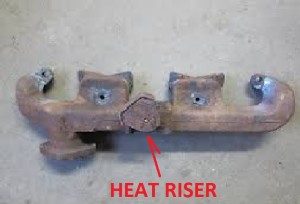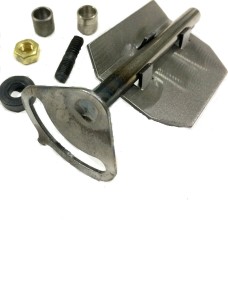A sticking heat riser can effect acceleration.
Notice there is a connection between your intake manifold and exhaust manifold on most stock/original Plymouth or Dodge early sixes. Located in the exhaust manifold just below that connection is a heat riser that provides a heat source for warming up the intake manifold. A butterfly valve that is thermostatically controlled to open and close depending on the temperature is the “heat riser” control that determines how much heat is applied to the intake manifold. This valve can freeze up due to deposits and rust or the spring that operates the butterfly can deteriorate. The net result can be a stumble or lack of acceleration when the accelerator pedal is depressed. Flathead & Slant sixes have the similar heat riser functions.
You can check the heat riser function by observing the counterweight that should move freely when rotated; if it drags or hangs up…… then the hear riser may be sticking and contributing to the lack of acceleration when desired.
The Dodge & Plymouth boys extended a fairly measure-able effort to provide this valve so it’s importance must not be small?
The theory on what is happening is explained by this write-up:
http://www.langdonsstovebolt.com/tech/why-you-need-to-heat-your-intake-manifold/
In the above case the publisher is addressing a problem that occurs when a heat riser is eliminated (when exhaust manifolds are changed for example to headers) however it also somewhat applicable when a heat riser is sticking or not rotating as a butterfly valve should when temperature conditions vary.
In some cases a special lubricant for the heat riser butterfly can be applied. In other cases a heat riser spring or bushings must be replaced. I have used the Mopar Rust Penetrant MS-3613 part number 04318039AB successfully for years on the heat riser bushings. If the heat riser is seized then a kit including bushing and valves can be purchased to rebuild the exhaust manifold:
The other good maintenance practice could be as simple as simply rotating the valve often (when the manifold is cool of course).
It’s a good practice to check the heat riser functionality frequently. It makes it easier to spot the beginnings of it starting to stick so you can take the action of applying lubricant before the valve becomes seized; a little lubricant in time saves a lot of rebuilding work to refurbish the heat riser.


